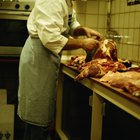
You can use almost any cut of beef to make soup, but some are especially good. Arguably the best of all is shank, the tough and gristly meat from the steer's legs. Shank is the most intensely beefy-tasting cut of all, and it's unmatched in its ability to create a richly fragrant broth while retaining a strong flavor of its own. Making the best beef soup of your life requires little more than a stack of shank slices and a little patience.
Where the Magic Starts
The shanks include some of the most-used muscles in the entire carcass of the steer, used whenever the animal wasn't lying down. This makes the muscles exceptionally dense, which accounts for much of their flavor. Shanks are also filled with tough, gristly connective tissue, which -- unlikely though it sounds -- plays a large role in soup-making. With long, slow cooking, those connective tissues dissolve into natural gelatin that gives the broth its rich body and mouth feel. The softened gelatin also makes the meat meltingly tender and keeps it moist even after extended cooking.
Getting Them Ready
Butcher shops occasionally offer shanks whole, but more often you'll find them sliced crosswise into slabs ranging from 1/2 inch to 1 1/2 inches in thickness. For soup, 3/4 inch to 1 inch is ideal. Take them home and wipe the cut edges of the bone with a clean cloth or paper towel, to remove any bone fragments that might be left behind. You can drop them directly into your soup pot and start cooking, but they'll have a deeper and more complex flavor if you brown them first. You can sear them in a hot skillet on the stove top or char them on your grill or under a broiler. Either method works fine.
Simmering Your Shanks
Put the shanks in your favorite soup pot, along with water, a bay leaf, some coarsely chopped onion, and other aromatic ingredients such as garlic, carrots and celery depending on the flavor you want to create. Bring the pot to a gentle simmer, skimming off the grey-brown foam that rises to the surface. The pot shouldn't boil; instead, let it get just hot enough for the surface to ripple. At that temperature, it should take between 1 1/2 and 2 hours for the shanks to become completely tender. When you can easily insert a fork and twist off a mouthful of beef, they're done. Lift out the shanks and strain the aromatics from the broth.
Finishing the Soup
The broth will have some fat floating on the surface, which you can skim off or blot up with paper. If you have time, it's easiest to refrigerate the broth until the fat hardens and then just lift it out. When the shanks are cool enough to handle, peel off the ring of rubbery gristle that encircles each slice. The meat will separate from the bone in several rounded nuggets, corresponding to the individual leg muscles. Coarsely chop or shred the meat, and reserve it. Bring your broth back to a simmer, and add your choice of vegetables and seasonings. When the vegetables are tender and have absorbed the broth's flavor, add the shank meat back to the pot.
Related Articles

How Do I Cook Pork Spine?
How to Boil Pork Jowl Bacon

How to Cook Cabbage With Turkey Necks

How to Tenderize a Large Old Chicken

How to Cook Beef Top Round Pot Roast

How to Blanch Beef

How to Boil Beef

How to Tenderize Gizzards

How to Cook a Large Amount of Corned ...
How to Know When a Boiled Picnic ...

How to Cook Tripe

How to Cook Silverside on a Stove Top
How to Boil Whole Chicken Giblets

How to Slow Cook Brisket With Brown ...

How to Cook Pulled Beef Without a Slow ...

Can Beef Shoulder Roast Be Sliced and ...

How Long to Slow Cook Eye Round Roast ...

How to Cook Beef Country-Style Strips

Cuts of Meat From a Front Quarter of ...

How to Make Collard Greens With Smoked ...
References
- On Food and Cooking: The Science and Lore of the Kitchen; Harold McGee
- NPR Kitchen Window: The Secret Strength of Beef Soup
Writer Bio
Fred Decker is a trained chef and prolific freelance writer. In previous careers, he sold insurance and mutual funds, and was a longtime retailer. He was educated at Memorial University of Newfoundland and the Northern Alberta Institute of Technology. His articles have appeared on numerous home and garden sites including GoneOutdoors, TheNest and eHow.
Photo Credits
Eising/Photodisc/Getty Images